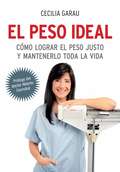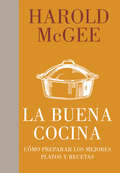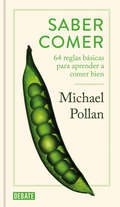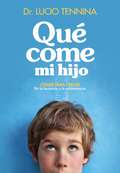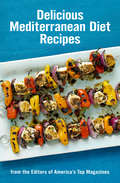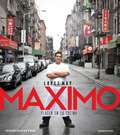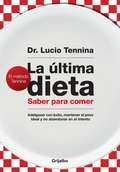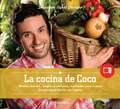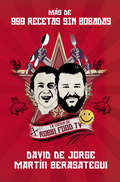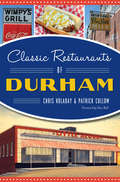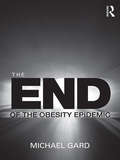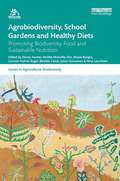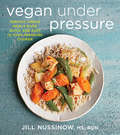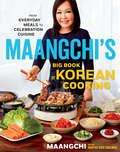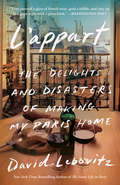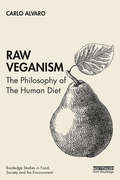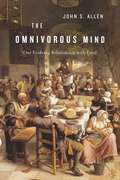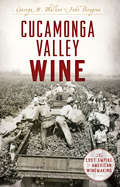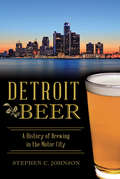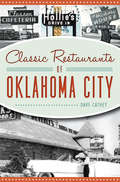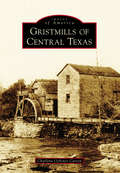- Table View
- List View
El peso ideal: Cómo lograr el peso justo y mantenerlo toda la vida
by Cecilia GarauUn propuesta de alimentación saludable para reeducar nuestro paladar,dejar de lado las dietas mágicas y las conductas obsesivas relacionadascon la comida, y al fin aprender a comer. «A través de su enfoque familiar y nutricional, Cecilia Garau estimulala planificación y el comer consciente ofreciendo recursos prácticos. Loque sugiere es posible, y su mirada positiva permite construir unanoción sobre cómo mejorar el acto de comer con cambios simples, alalcance de todos». Alberto CormillotCecilia Garau cuenta con la experiencia profesional y propia, porqueella misma mantiene su peso ideal con naturalidad. Así, tira por laborda varios mitos que nada tienen que ver con la buena alimentación ynos explica cómo funcionan las dietas más famosas y por qué sonpeligrosas a largo plazo. Nos enseña a autodiagnosticar cómo comemos, adescifrar qué se esconde detrás de las etiquetas de los productos, acomprar mejores alimentos, a conocer qué deben comer los niños y lasembarazadas, a comer en familia, en salidas- como dice la autora- apasar «de la cajita feliz a la caja de herramientas para aprender aalimentarnos».Este libro nos acerca a la ciencia de la nutrición para descubrir todolo que no sabemos sobre nuestra alimentación.
La buena cocina: Cómo preparar los mejores platos y recetas
by Harold McGeeUna guía diseñada para ayudar a esos cocineros caseros que tienen que lidiar con todo un universo de ingredientes, recetas, y electrodomésticos en constante expansión para alcanzar esa tierra prometida que es un plato bien hecho. La buena cocina está destinado a convertirse en una pieza esencial del repertorio de cocina de cientos de miles de lectores en todo el mundo, una asombrosa y original obra que dirige los esfuerzos del chef a la vez que resuelve con rapidez todas las dudas que surgen en los fogones del aficionado. McGee ha creado en un solo volumen de fácil uso: la guía esencial para los amantes de la cocina, apta para todo tipo de cocineros: desde los principiantes que necesitan aprender, pasando por los que quieren conocer mejor las artes culinarias o los profesionales que buscan nuevos planteamientos teóricos para elaborar el mejor plato. La buena cocina destila todo el saber de la ciencia moderna de los alimentos y lo traduce en información útil: nos conduce del mercado a la mesa y nos explica la importancia de los ingredientes ya sean comunes o exóticos en el resultado final, así como las técnicas a emplear en su preparación, con un estilo directo y humilde que contagia su entusiasmo por la gastronomía. Reseña:«Esta nueva aportación de McGee volverá a ser una obra imprescindible para todo aquel que ame la cocina en cualquiera de sus variantes.»Del prólogo de Martín Berasategui
Saber comer: 64 reglas básicas para aprender a comer bien (Vintage Espanol Ser.)
by Michael PollanEl libro definitivo para comer bien y de froma inteligente. Frente a las dietas, sentido común. Comer no tiene que ser tan complicado. En esta época de dietas milagrosas demasiado elaboradas y consejos contradictorios sobre salud y nutrición, Saber comer nos ofrece 64 reglas básicas para nuestra alimentación diaria. Escrito con claridad, precisión, y una agudeza que lo ha llevado a convertirse en un bestseller, este manual indispensable bebe de una gran variedad de tradiciones y nos muestra cómo las distintas culturas han alcanzado a través de los siglos una sabiduría común sobre la comida. Saber comer es un manual perfecto para gente con sentido común y para todo aquel que alguna vez se haya preguntado «¿qué, cuándo, y cómo debería comer?». Reseñas:«En las cuatro décadas que llevo leyendo y escribiendo sobre nutriciónnunca había encontrado nada tan inteligente, sensato y fácil como estas 64 reglas.»Jane Brody, The New York Times «Destinada a convertirse en una guía de referencia para comer bien, sin necesidad de leer largos manuales sobre nutrición.»Los Angeles Times «Un manual práctico que reemplazará todos los libros de dieta en tu estantería.»The New York Times
Qué come mi hijo: Comer para crecer. De la lactancia a la adolescencia
by Lucio TenninaQué deben comer los chicos en cada etapa de crecimiento y cómo debenincorporar los alimentos para adecuarlos a los cambios en sus cuerpos ya las necesidades que estos conllevan. Incluye menús semanales con uncompleto equilibrio de nutrientes y viandas escolares aconsejables paracada día de la semana. Hoy circula mucha información equivocada acerca de los alimentos. LucioTennina, experto médico nutricionista de gran trayectoria y éxitoprobado, escucha hace años a padres desorientados acerca de la comidacon la que alimentan a sus hijos e insiste en que la clave sigue siendosaber para comer. Este libro tiene ese punto de partida.Luego de la lactancia, cuando se amplía la dieta del niño, ¿qué hacemos?¿Por qué el bebé come verduras hasta el año y medio y luego las detesta?¿Qué le transmitimos?«Qué come mi hijo» es una oportunidad para mejorar la calidad de vida detoda la familia y ayudar a nuestros niños en el desarrollo de una vidasana.
Delicious Mediterranean Diet Recipes: From the Editors of America's Top Magazines
by HearstMouthwatering Mediterranean recipes for every meal, to keep you healthy and satisfied "About 30 percent of heart attacks, strokes and deaths from heart disease can be prevented in people at high risk if they switch to a Mediterranean diet rich in olive oil, nuts, beans, fish, fruits and vegetables, and even drink wine with meals." --The New York TimesIt's true--a diet including pasta, cheese, wine, and dessert really can trim your waistline and improve your overall health. A 2013 study published in the New England Journal of Medicine proves that adopting a Mediterranean diet reduces the risk of stroke and heart disease while keeping your taste buds satisfied. Full of fresh vegetables, fruits, legumes, fish, and poultry, this high-protein diet will never leave you feeling hungry. Praised by the New York Times and food expert Mark Bittman, this is a plan you'll want to stick to for life.These flavorful, colorful, and easy-to-prepare dishes provide plenty of variety for every meal of the day. Enjoy delicious recipes such as:· Asparagus-Romano Frittata· Chicken Gyros· Santa Fe Falafel· Sizzling Steak Kebabs· Red Wine-Poached Salmon· Buttermilk Panna Cotta with Blackberrry SauceThis collection makes it easy to stay healthy without feeling deprived. Start enjoying fresh and exotic meals inspired by the traditional eating habits of the countries bordering the Mediterranean Sea.
Máximo: Placer en la cocina
by Máximo López MaySu primer libro de cocina reúne más de cien recetas, desde las mássimples y fundamentales hasta las más clásicas y tradicionales. Comidas con pocos ingredientes, sin cocción, de olla, a la parrilla.Caldos, harinas, pescados, carnes, ensaladas, postres. Una colección deplatos de dignos y apetitosos, hechos con sensibilidad e instinto, lascualidades más preciadas a la hora de cocinar. El lectortambién encontrará versiones de preparaciones icónicas de Francia,México, Italia, Alemania, y otros países que son fuente interminable deinspiración en materia gastronómica.«Máximo placer en la cocina» es, en definitiva, una combinación dearomas, misterios, recuerdos, sofisticación, modernidad y,especialmente, simpleza. Una característica a menudo olvidada en lacocina y que puede sintetizarse en unas pocas reglas. «Menos es más»,porque un plato perfecto requiere cinco ingredientes o menos. «Simple noes fácil», ya que la sobreelaboración no implica grandeza. Y esforzarseen la búsqueda del producto perfecto, porque -como dice este joven chef-«En lo que se elige con cuidado y ternura siempre se encuentra labelleza verdadera». Una invitación al arte y la pasión de cocinar. Confotografías de Zia O'Hara.
La última dieta: Saber para comer
by Lucio TenninaLa manera más eficaz de adelgazar con éxito, mantener el peso ideal y noabandonar en el intento: El método Tennina. Sufrir de sobrepeso es uno de los mayores motivos de desvelo de hombresy mujeres. Mirarse al espejo y no gustarse genera frustración.Pero restringir el menú también produce insatisfacción. La cadena es lasiguiente: ansiedad-ingesta-culpa. Sin embargo, la solución a esteproblema no es difícil.La clave se reduce a saber para comer. En este libro, el doctor LucioTennina revierte una creencia arcaica: no somos culpables ni adictos alo que comemos, sino que hay alimentos descontrolantes y adictivos.Reconocerlos y apartarlos de nuestra dieta es el primer paso paraadelgazar. Una comida adecuada respeta las leyes de la naturaleza, nosmantiene sanos y con un peso estable. Da energía, sostén y, sobre todo,salud al organismo.«La última dieta» nos advierte sobre los alimentos prohibidos y losnecesarios. Nos hace recuperar la lucidez e inteligencia que la malacomida nos hace perder. Nos invita a reeducar las nociones aprendidasacerca de lo que comemos y cocinamos. Y nos ofrece 100 recetas paraadelgazar comiendo rico y sano.
La cocina de Coco: Recetas caseras, simples y sabrosas, explicadas paso a paso
by Sebastián Agost CarreñoMi experiencia como cocinero, mi pasión y respeto por este oficio estánpuestos en cada página. Te invito a mi cocina: simple, sabrosa yrealizable Este es mi primer libro de recetas, probadas en el corazón de mi propiacasa: mi cocina. Un libro de consulta como los de antes, esos con losque de verdad salías airoso. Para escribirlo dejé de lado mi espíritumás aventurero y me concentré en lo aprendido en dieciocho años deprofesión. Con más de 120 recetas, está pensado para los que saben decocina y los que no, para todos los paladares y bolsillos, con el justoequilibrio entre el sabor de lo casero y el toque #gourmet# que me gustadarle a mis platos. Para que puedas resolver con ingenio tus comidasdiarias y para que también te luzcas en alguna ocasión especial. Miexperiencia como cocinero, mi pasión y respeto por este oficio estánpuestos en cada página. Te invito a mi cocina: simple, sabrosa yrealizable.Coco
Más de 999 recetas sin bobadas: La cocina de Robin Food TV
by Martín Berasategui David De Jorge999 recetas prácticas para cada día, elaboradas por uno de los cocineros más reputados del país. Más de 999 recetas sin bobadas llega de la mano de dos de las estrellas más brillantes del firmamento gastronómico, Martín Berasategui y David de Jorge. Recetas prácticas para el menú de cada día presentadas en el programa de cocina más irreverente y de más audiencia de la televisión vasca: Robin Food. Atracón a mano armada. Una cocina sencilla y con sentido común toma forma en este nutrido recetario que se aleja de las extravagancias y de los ingredientes exóticos, recetas para gente ocupada y con buen gusto: ensaladas, sopas y cremas, bocadillos, salsas y aderezos, pero también platos elaborados y cócteles para las ocasiones más especiales.
Classic Restaurants of Durham (American Palate)
by Chris Holaday Patrick CullomThe story of the restaurant industry in Durham is also the story of a once prosperous tobacco town that suffered through a long decline only to undergo a stunning rebirth. Legendary barbecue restaurants such as Little Acorn, Bullock's and Dillard's and small cafés like Lewis' served generations of tobacco industry workers. Establishments such as Annamaria's and the Ivy Room were aimed at the growing college student population. More recently, Nana's, Magnolia Grill and other award-winning eateries have led a restaurant renaissance. This book profiles fifty longtime restaurants that have helped shape the city's dining scene--from small takeout sandwich shops to the finest of fine dining. Local authors Chris Holaday and Patrick Cullom tell the story of Durham's unique food history.
Making a Sandwich (Fountas & Pinnell Classroom, Guided Reading Kindergarten)
by Dave Bradley Leo AllenNIMAC-sourced textbook
The End of the Obesity Epidemic
by Michael GardDespite apocalyptic predictions from a vocal alliance of health professionals, politicians and social commentators that rising obesity levels would lead to a global health crisis, the crisis has not materialised. In this provocative follow up to his classic work of obesity scepticism, The Obesity Epidemic, Michael Gard argues that we have entered into a new, and perhaps terminal, phase of the obesity debate. Evidence suggests that obesity rates are levelling off in Western societies, life expectancies continue to rise in line with rising obesity rates, and across the world policy-makers have remained largely indifferent and inactive in the face of this apparently deadly threat to our health and well-being. Dissecting and dismissing much of the over-blown rhetoric and ideological bias found on both sides of the obesity debate, Gard demonstrates that the science of obesity remains radically uncertain and that it is impossible to establish an objective ‘truth’ on which to base policy. His powerful and inescapable conclusion is that we should now mark the end of the obesity epidemic. Offering a road map through the maze of claims and counter-claims, while still holding to a sceptical standpoint, this book provides an unparalleled anatomy of obesity as a scientific, political and cultural issue. It is essential reading for anybody with an interest in the science or sociology of health and lifestyle.
All Kinds of Seeds (Fountas & Pinnell Classroom, Guided Reading)
by S. J. KentcornNIMAC-sourced textbook. Lots of Seeds. All fruits have seeds. But there are lots of different kinds of seeds.
Growing Lettuce (Fountas & Pinnell Classroom, Guided Reading)
by Robert Reynolds Madeline HydeNIMAC-sourced textbook. Recycling Food Scraps. Scraps are the stems, seeds, and tops of fruits and vegetables left after cooking a meal. You can grow plants from some scraps. Read this book to find out what the girl grows.
Agrobiodiversity, School Gardens and Healthy Diets: Promoting Biodiversity, Food and Sustainable Nutrition (Issues in Agricultural Biodiversity)
by Danny HunterThis book critically assesses the role of agrobiodiversity in school gardens and its contribution to diversifying diets, promoting healthy eating habits and improving nutrition among schoolchildren as well as other benefits relating to climate change adaptation, ecoliteracy and greening school spaces. Many schoolchildren suffer from various forms of malnutrition and it is important to address their nutritional status given the effects it has on their health, cognition, and subsequently their educational achievement. Schools are recognized as excellent platforms for promoting lifelong healthy eating and improving long-term, sustainable nutrition security required for optimum educational outcomes. This book reveals the multiple benefits of school gardens for improving nutrition and education for children and their families. It examines issues such as school feeding, community food production, school gardening, nutritional education and the promotion of agrobiodiversity, and draws on international case studies, from both developed and developing nations, to provide a comprehensive global assessment. This book will be essential reading for those interested in promoting agrobiodiversity, sustainable nutrition and healthy eating habits in schools and public institutions more generally. It identifies recurring and emerging issues, establishes best practices, identifies key criteria for success and advises on strategies for scaling up and scaling out elements to improve the uptake of school gardens.
Vegan Under Pressure: Perfect Vegan Meals Made Quick And Easy In Your Pressure Cooker
by Jill NussinowVegan cooking made fast, fresh, and flavorful with the convenience of a pressure cooker, including all the essential info for using the appliance safely and effectively, and 175 recipes.
Maangchi's Big Book of Korean Cooking: From Everyday Meals to Celebration Cuisine
by Martha Rose Shulman MaangchiThe New York Times Best Cookbooks of Fall 2019Eater Best Fall Cookbooks 2019Bon Appetit's "Fall Cookbooks We've Been Waiting All Summer For" Amazon's Pick for Best Fall Cookbooks 2019Forbes Finds 15 New Cookbooks for Fall 2019 The definitive book on Korean cuisine by “YouTube's Korean Julia Child”* and the author of Maangchi’s Real Korean Cooking *New York Times Despite the huge popularity of Korean restaurants, there has been no comprehensive book on Korean cooking—until now. Maangchi’s Big Book of Korean Cooking is a wide, deep journey to the heart of a food-obsessed culture. The book contains the favorite dishes Maangchi has perfected over the years, from Korean barbecue and fried chicken to bulgogi and bibimbap. It explores topics not covered in other Korean cookbooks, from the vegan fare of Buddhist mountain temples to the inventive snacks of street vendors to the healthful, beautiful lunch boxes Korean mothers make for their kids. Maangchi has updated and improved the traditional dishes, without losing their authentic spirit. Among the features: • Spectacular party food, from homemade clear rice liquor to sweet, spicy, sour baby back ribs • Side plates that support and complement every Korean meal • Soups, hotpots, and stews, from bone broth to tofu stews • An array of different kimchis • A detailed photographic chapter on Korean cooking techniques Hundreds of striking, full-color photos by Maangchi show Korean ingredients so the cook knows exactly what to buy, step-by-step techniques for each recipe, and tempting close-ups of every dish.
Cake in a Cup (Fountas & Pinnell Classroom, Guided Reading)
by Avery DeCiccoNIMAC-sourced textbook. Mug Cakes, It's fun to make a cake in a mug, or cup. You can use a microwave oven to do it. Read to find out how.
L'Appart: The Delights and Disasters of Making My Paris Home
by David LebovitzBestselling author and world-renowned chef David Lebovitz continues to mine the rich subject of his evolving ex-Pat life in Paris, using his perplexing experiences in apartment renovation as a launching point for stories about French culture, food, and what it means to revamp one's life. Includes dozens of new recipes. When David Lebovitz began the project of updating his apartment in his adopted home city, he never imagined he would encounter so much inexplicable red tape while contending with the famously inconsistent European work ethic and hours. Lebovitz maintains his distinctive sense of humor with the help of his partner Romain, peppering this renovation story with recipes from his Paris kitchen. In the midst of it all, he reveals the adventure that accompanies carving out a place for yourself in a foreign country—under baffling conditions—while never losing sight of the magic that inspired him to move to the City of Light many years ago, and to truly make his home there.
Raw Veganism: The Philosophy of The Human Diet (Routledge Studies in Food, Society and the Environment)
by Carlo AlvaroHuman beings are getting fatter and sicker. As we question what we eat and why we eat it, this book argues that living well involves consuming a raw vegan diet. With eating healthfully and eating ethically being simpler said than done, this book argues that the best solution to health, environmental, and ethical problems concerning animals is raw veganism—the human diet. The human diet is what humans are naturally designed to eat, and that is, a raw vegan diet of fruit, tender leafy greens, and occasionally nuts and seeds. While veganism raises challenging questions over the ethics of consuming animal products, while also considering the environmental impact of the agriculture industry, raw veganism goes a step further and argues that consuming cooked food is also detrimental to our health and the environment. Cooking foods allows us to eat food that is not otherwise fit for human consumption and in an age that promotes eating foods in ‘moderation’ and having ‘balanced’ diets, this raises the question of why we are eating foods that should only be consumed in moderation at all, as moderation clearly implies they aren’t good for us. In addition, from an environmental perspective, the use of stoves, ovens and microwaves for cooking contributes significantly to energy consumption and cooking in general generates excessive waste of food and resources. Thus, this book maintains that living well and living a noble life, that is, good physical and moral health, requires consuming a raw vegan diet. Exploring the scientific and philosophical aspects of raw veganism, this novel book is essential reading for all interested in promoting ethical, healthful, and sustainable diets.
The Omnivorous Mind: Our Evolving Relationship with Food
by John S. AllenIn this gustatory tour of human history, Allen suggests that the everyday activity of eating offers deep insights into our cultural and biological heritage. Beginning with the diets of our earliest ancestors, he explores eating's role in our evolving brain before considering our contemporary dinner plates and the preoccupations of foodies.
Cucamonga Valley Wine: The Lost Empire of American Winemaking (American Palate)
by George M. PeragineThe Cucamonga Valley was once America�s largest wine-producing region, crafting quality vintages decades before Napa and Sonoma. Secondo Guasti, an ambitious and enterprising Italian immigrant, established the region�s first vineyard in 1901, and others soon followed. Wineries like the Vai Brothers, Padre, Galleano, Brookside and more made the valley the epicenter of a burgeoning industry. Not even Prohibition could halt production. While domestic breweries and distilleries shuttered, Cucamonga�s brandy and sherry continued to be legally made for culinary and medicinal purposes. Yet by the late 1970s, harvests had dwindled and vineyards vanished. Urbanization, vine disease and property taxes effectively ended production. Today, local vintners and wine enthusiasts are reviving the region�s proud heritage. Authors George M. Walker and John Peragine uncork a legacy too delectable to die.
Detroit Beer: A History of Brewing in the Motor City (American Palate)
by Stephen C. JohnsonWhile in recent years Detroit's craft beer scene has exploded with activity and innovation, brewing has a long history in the Motor City. Small brewers popped up during the mid-1800s to support nearby saloons. Many breweries survived the dry years by producing "near beer," or non-alcoholic beer, which was quickly abandoned after Prohibition. Consolidation marked the following decades until only Stroh Brewery Company remained. Local brewing returned triumphantly with dozens of breweries opening their doors since the 1990s, including Motor City Brewing Works, Atwater Brewery and Kuhnhenn Brewing Company. Join author and Motor City Brew Tours founder Stephen Johnson for Detroit history by the pint.
Classic Restaurants of Oklahoma City (American Palate)
by David CatheySome of Oklahoma City's earliest famous restaurants included a side of gambling, bootlegging and mayhem. Cattlemen's Café changed hands by a roll of the dice one Christmas. In more recent years, establishments like O'Mealey's and Adair's positioned the city's identity as a unique, groundbreaking culinary hub. The city became known as the Cafeteria Capital thanks to the revolutionary approach of a diminutive Kansas woman named Anna Maude Smith. Beverly's Chicken-in-the-Rough became a national fried-chicken franchise two decades before Harland Sanders sold his first drumstick. And world-renowned chef Rick Bayless first learned to cook at his parents' barbecue restaurant in south Oklahoma City. Join author Dave Cathey as he dishes on these delectable stories and more.
Gristmills of Central Texas (Images of America)
by Charlene Ochsner CarsonGristmills were once commonplace in Texas. There was hardly a river, a creek, or a stream without one. The purpose of the gristmill was to grind wheat into flour and corn into meal. Prior to the water-powered gristmill, grinding was a tedious, time-consuming task that was usually performed by hand using some type of mortar and pestle. When a gristmill began operating in an area, settlers from near and far traveled to the mill to have their grain ground. The gathering of these settlers and farmers at the mill was the beginning of many settlements that grew into the Texas towns of today. Many of these picturesque settings have become major tourist destinations.
